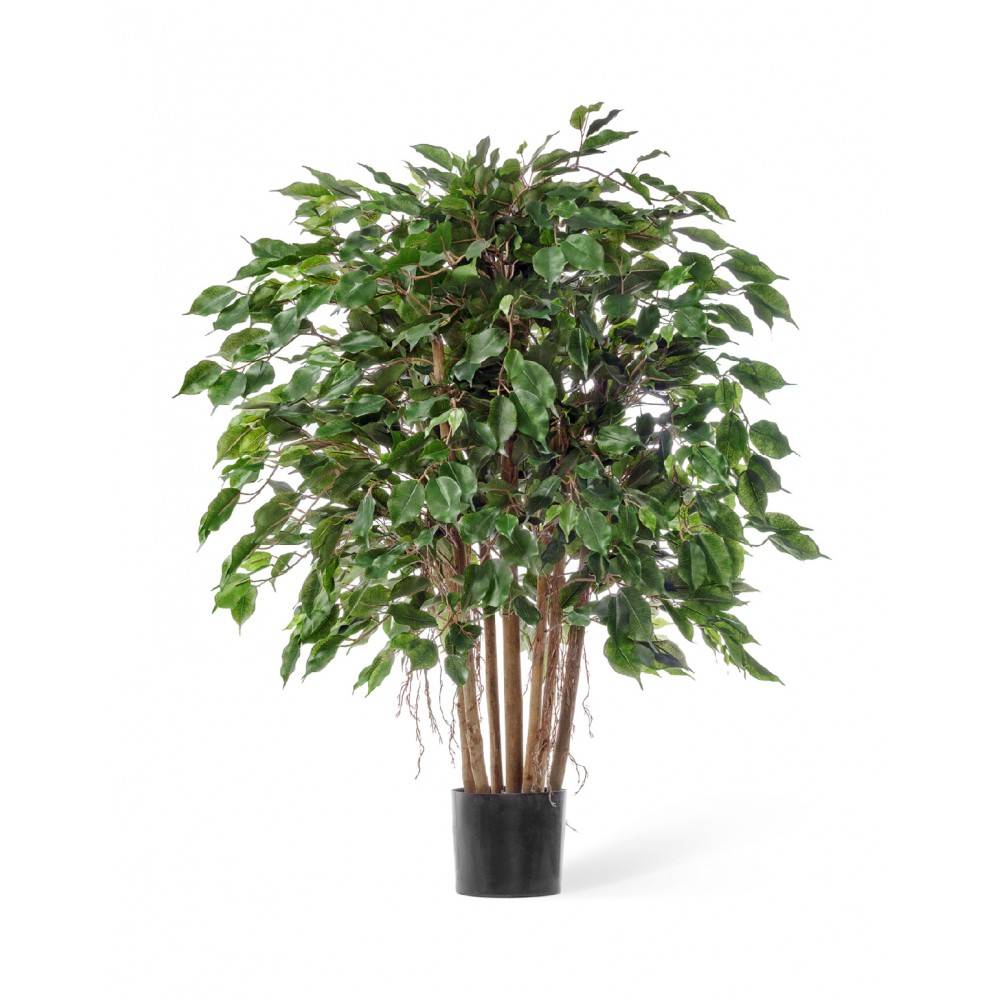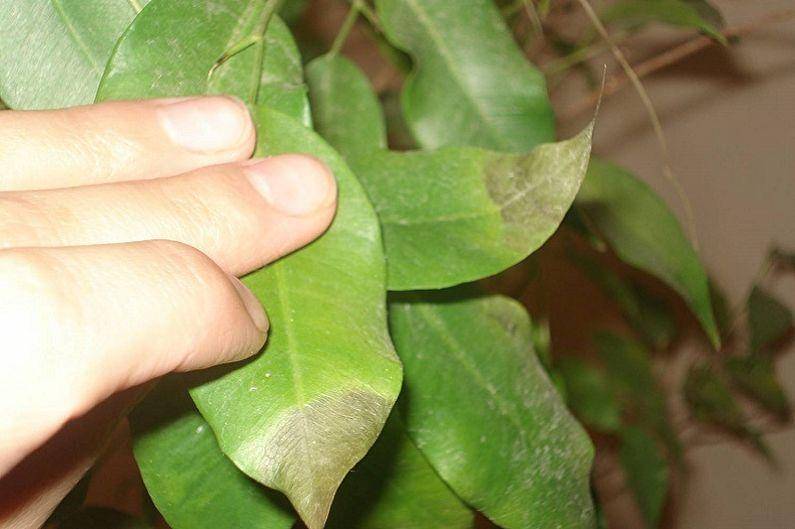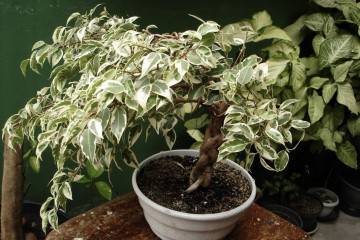Ficus Benjamin - description and care at home
Content:
Among the genus of ficuses, the most common type of Benjamin (Ficus Benjamina). Its natural habitat is in the tropics of Asia. It survives well in rainy areas, especially at the foot of the mountains. The plant is suitable for revitalizing the interior of homes and offices. Ficus Benjamin needs proper care at home, plenty of sunlight. If these conditions are met, the crown of the flower will be lush.
What does Benjamin's ficus look like?
The plant is native to the tropics of Asia. In its natural environment, it can be found in India, Australia, China. Ficus loves humidity and high ambient temperatures. Despite the prevalence only in humid climates, the plant takes root in the middle latitude, for example, in Russia. But this requires proper care.
Typical description of the plant:
- evergreen leaves at any time of the year;
- growing in the form of a tree or shrub (the maximum size in natural habitat is up to 25 m);
- leaves are smooth glossy oval with a pointed tip;
- the bark on the trunk is brown;
- the crown is abundant and wide;
- the leaves are poisonous, belong to the 4th class of toxicity;
- small fruits of red or orange hue are not edible.
At the beginning of the XX century. the variety was bred by botanist B. D. Jackson. He compiled a guide to flowering plants, describing more than 500 varieties.
Only after many decades did the ficus become popular as an indoor ornamental plant. Anyone can choose a variety for themselves to their liking, since different varieties can have different shades and leaf shapes.
Some growers are interested in what useful properties the plant has:
- antiviral, antibacterial effect;
- removal of inflammation;
- increased metabolism, thereby improving the regeneration of damaged tissues.
Extracts from leaves and roots are used to treat dental diseases, boils, soft tissue damage, eliminate inflammation in the digestive tract and reproductive system.
Features of caring for a flower at home
Since the plant grows in habitat conditions that are not typical for it, a person must improve them on his own. To do this, maintain the optimal temperature, humidity, illumination. The soil is fertilized, watered on time.
Temperature
The optimum temperature for a plant and a person is similar. The minimum should be 16 ° C, and the maximum should be 23 ° C.
The most important condition is a sufficient amount of fresh air. The shrub can even be taken out onto the balcony if it is protected from the wind. It is placed on the windowsill, then you need to periodically open it for fresh air. Other windows and doors should be closed, as the draft will negatively affect the plant.
Lighting
Ficus grows in a lot of sunlight. But it should not fall directly on the sheets, as this is fraught with burns.The light should be softly diffused throughout the room.
Watering
The soil should always remain moist, as the shrub loves abundant watering. This is especially true for the summer period. If the soil dries out, the leaves will wither quickly. In autumn and winter, the amount of watering is reduced to once every seven days.
Despite the need for constant watering, the soil should not be over-flooded. This can lead to the development of rot, various types of infection. But the soil should be watered as soon as the top layer of soil in the pot is dry.
Spraying
Water should be contained not only in the soil, but also on the leaves, since the plant is native to the tropics. Spray with water from a spray bottle, processing all the leaves. This will additionally add moisture to the shrub, eliminate accumulated dust.
Humidity
Indoor humidity should be 60-70%. The same indicators are true for humans. Sometimes, in addition to spraying and maintaining moisture, you should water the shrub under the shower. This contributes to the healthy development of the plant, the prevention of viruses, infections, fungi, and various parasites.
Priming
In order for the root system to receive enough water and oxygen, they provide high-quality drainage for the soil. The acidic index of the soil should be neutral or slightly acidic. To do this, buy ready-made soil or do it yourself, adding leaves, peat, turf soil, charcoal.
Top dressing
After the winter period, the shrub needs special care. Otherwise, it becomes lethargic, the leaves are not fresh enough. As a top dressing, mineral fertilizer complexes are used, which are poured into the ground every two weeks.
Features of winter care
Shrub care in winter is slightly different than at other times of the year. This is due to the lack of lighting in the room in which the plant grows.
- There is not enough lighting in winter. It quickly moves from one room to another. In winter, the plant should be placed on a windowsill without fear of cold air. You can open a window so that sufficient fresh air can enter the room through the leaves of the bush.
- Temperature. If you put a shrub on a windowsill with an open window, you should avoid drafts. This will lead to leaf fall. Therefore, only one window is opened, while the others are closed. The plant is not afraid of cold weather.
- Watering. In winter, the concentration of water in the soil should be reduced without fear of drying out. If the soil becomes excessively dry, add a little water. On average, you need to water at least once a week. Florists believe that in winter ficus should be watered in the morning, and in summer - in the evening.
When and how it blooms
In nature, Benjamin's ficus blooms in spring. But if it is located indoors, this is extremely rare. Description of colors:
- small spherical peas in the form of berries;
- the presence of a cavity inside;
- the color can be yellow, green, orange;
- small holes may appear on the inflorescences (they are necessary for pollination, which is carried out only by insects from the tropics).
Inflorescences appear in shrubs grown in quality conditions. The plant must be healthy, full of energy. In this case, the leaves of the shrubs undergo a year-round leaf formation, but there will be no inflorescences and fruits.
Since many people are not used to such flowering and the formation of round inflorescences, they may mistake them for diseases.Therefore, you should first make sure of the presence or absence of parasites, only then start treatment as needed.
During the flowering period, there are no special changes in care. The plant still requires a lot of sunlight, which does not directly hit the leaves and inflorescences. It is worth watering often so that the soil does not dry out.
Pruning
The trunk of a shrub is not always thick enough to support overgrown foliage. To acquire the required thickness, the florist must plant several plants in one pot, intertwining them with each other. For this, the method of forming a pigtail from a tourniquet is suitable.
For beginner growers, it is recommended to practice pruning ficus. To do this, cut off the top of 3-4 buds. The procedure is repeated every 2-3 years so that the crown has the required shape. All sections are sprinkled with charcoal so that the liquid from the trunk does not flow out.
How Benjamin's ficus reproduces
There are various methods of reproduction, each one chooses the right one for himself. The main thing is to take into account the place and conditions of growth.
Cuttings
To propagate the plant, take apical cuttings. With the help of seeds, it is difficult or completely impossible to do this. To get a high-quality seedling, cut off tops with branches of leaves are used. They are wrapped in cheesecloth and placed in water. You can provide sufficient moisture by covering with a film.
If the resulting plant is capable of surviving, it will take root in about 2-3 weeks. After that, you need to root it in soil or sand, covering it with a plastic bag on top to create conditions in the greenhouse. The average temperature for normal growth should be 30 ° C, but there should not be excessive moisture.
This is the most efficient way to propagate the plant.
Seeds
It is extremely difficult to get the seeds of a plant; it is not easier to grow them. Without the conditions of a tropical climate, small-leaved ficus is not able to reproduce in this way. Therefore, flower growers rarely resort to this breeding option.
If a person decides to breed a shrub in a similar way, the actions are carried out in several stages.
- Soaking seeds in a weak solution of potassium permanganate. Treatment with special solutions designed to stimulate growth.
- First, drainage is laid in the pot, the soil is poured to a height of 10 cm.
- Sowing substrates are steamed. It is better to buy ready-made mixtures for ficuses. The substrate must not be compacted to ensure sufficient moisture and air supply.
- The seeds are spread evenly. If they are small, tweezers can be used.
- The seeds are re-covered with a layer of soil no more than 0.5 cm. Moisten with a spray bottle with water.
- Cover the top of the pot with plastic wrap or a glass jar.
- After the emergence of seedlings, the greenhouse effect cannot be abruptly removed, they do it gradually.
When the plant grows to 15 cm, it can be replanted.
Sheet
Fallen leaves are not suitable for reproduction. Cut off a small section of the twig, where only one leaf is located. The length of the shoot should be 7-8 cm. You need to cut it with a sharp knife. Further actions are carried out in several stages.
- The shoot is split, leaving in a glass of water. At least a day should pass. Milky juice should come out of the stem.
- Several cuts are made on the shoot, after which they are installed in a composition specially designed for the formation of roots.
- Set the shoot into the substrate, covering it with a cap or jar, creating a greenhouse effect. If, after a few days, another leaf appears, the plant has a root system.
Transfer
Ficus can grow up to several meters in height.At the same time, the volume of the root system increases. This leads to the need for a transplant. The most successful time for this is spring. If the plant is young, transplantation is carried out annually. For adult shrubs, the interval can be extended up to once every 2 years.
Possible growing problems and diseases
Among parasites, the following pests are most common:
- mealybug;
- shield;
- spider mite.
For the prevention and control of these insects, chemical solutions or homemade folk remedies are used.
The most common problem for flower growers is foliage falling. The reasons why this happens:
- insufficient watering and humidity in the room;
- a large amount of sunlight directly falling on the plant;
- draft, prolonged exposure to low temperatures;
- lack of light.
There may be other negative phenomena in the process of ficus growth:
- why the ficus sheds leaves and buds - not enough moisture and light;
- leaves turn pale - there is not enough mineral fertilizers in the soil;
- the tips of the leaves dry - dry soil, the need for more frequent watering;
- the lower leaves fall off - the spread of sunlight only on the upper leaves, without access to the lower ones;
- yellow leaves - waterlogging of the soil;
- new shoots are too thin - insufficient amount of light and mineral fertilizers;
- holes in the leaves, white bloom, the appearance of brown stripes on the trunk or leaves, which then crumble - infection of the plant.
Ficus Benjamin is a plant that grows well in indoor conditions, but subject to the required level of light and humidity. The flower is unpretentious, does not require frequent fertilization. If you care for it carefully, the ficus will delight with its lush crown and maybe even bloom.






















